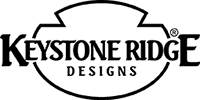July 13, 2015
Guide To Understanding Plaques
We get a lot of questions about incorporating plaques into site furnishings. Whether you are looking to memorialize, pay tribute, offer donor recognition or provide wayfinding, here is our Guide to Plaques.
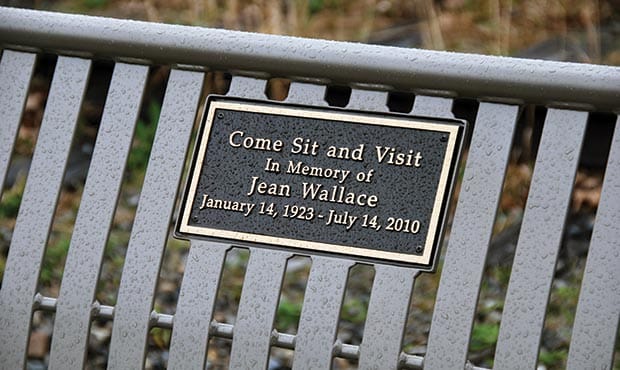
Step 1: Consider the Product
Our most common plaque application is on a bench, but we also do customized plaques on many different products. The product that you pick will help to determine the best size for your plaque.
- Bench – A standard bench plaque is 10”x5”. It’s installed in the center and inset into the back with a plaque tray. Custom larger sizes have included 10”x10”, 14”x8” and many more.
- Litter Receptacle – Standard size is 7”x3”. A good option for a smaller message. Another idea is to curve a plaque in a band around the receptacle.
- Table Set – 7”x3” plaque inset into the back of one or multiple chairs.
- Bollard – 6”x6” round plaque as a marker on the top of an angled bollard.
- Plaque Stand – Can be done in a variety of sizes to fit the message. A perfect option for wayfinding, historical markers or dedications.
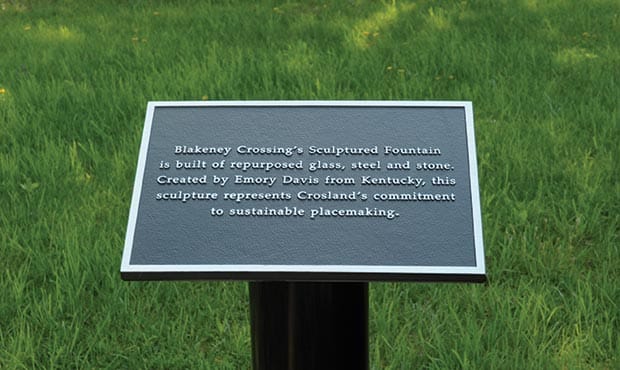
Step 2: Consider the Purpose
Defining the application and overall purpose of your plaque helps to influence other plaque decisions such as material and color.
- Will it be outdoors?
When it comes to materials for outdoor environments, bronze is best. Cast bronze plaques are thicker, harder and more durable than other signage materials. With an age-old method of casting in sand, it conveys an image of quality and tradition. The most common material we use for plaques is cast bronze, however we have additional capabilities to create lighter-weight plaques out of aluminum, thinner, more detailed plaques made of zinc and other custom materials as requested. - Are you trying to match anything else already onsite?
A standard cast bronze plaque comes with raised bronze lettering and a textured brown background. We also offer a variety of background colors to best coordinate with surroundings. Alternative materials such as aluminum can showcase different metal tones.
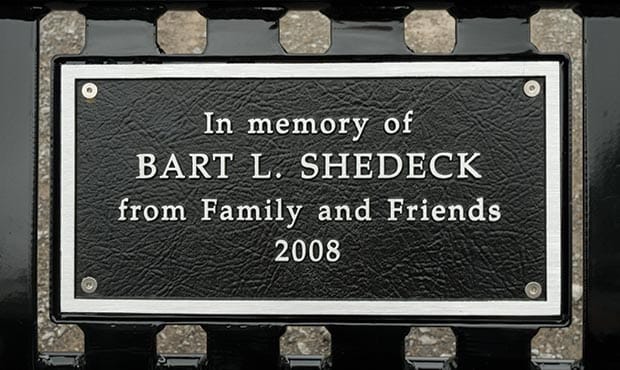
- Is it for a sponsorship program?
If starting a sponsorship program where multiple donors will request plaques over time, be sure to define parameters in advance regarding size, colors and text requirements to maintain a consistency throughout your property.
Step 3: Consider the Message
Once you know the product and the general purpose, you can determine what you would like your plaque to say. Keep the following in mind:
- Characters – On a standard 10”x5” plaque, 50 characters is average but we can do up to 120 characters. If you need more text, options are available for larger custom sizes.
- Fonts – Simple fonts work best with the casting process. Small lettering with fine serifs is not recommended. We commonly use Palatino Roman but another good sans serif font is Helvetica. If you have a lot of text that will require a small font size, using all upper case letters will help to keep small spaces from filling in during casting.
- Images – If you have an image, emblem or logo that you would like to incorporate on your plaque, all you need is a vector file - .ai or .eps. We even have the capability to cast a photographic image into a plaque using a high-res .jpg file.
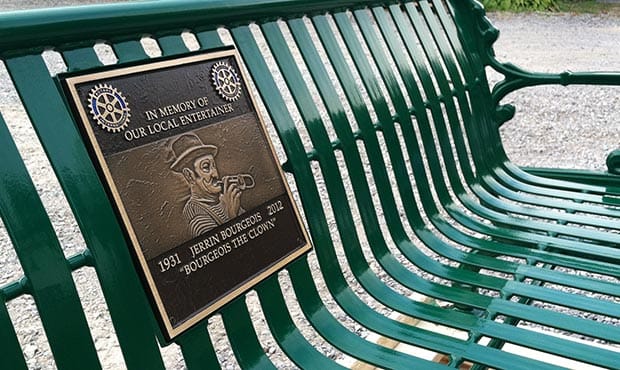
Step 4: Always review a proof
Always plan to thoroughly review a proof prior to production. Because of the intensive manufacturing process of casting plaques, once a plaque is cast, it is not easy to make corrections. A proof is your chance to make sure your plaque will look exactly the way you want it.
So if you want your site furnishings to make a statement, do some preliminary planning and say it with a plaque. Feel free to download more information on our plaques by clicking here.
-
❰ Previous
Four Trends In Site Furniture ❰ Previous Post
ARCHIVES
- Sustainability At Keystone Ridge Designs
- Mix And Match Site Furniture Designs
- Planning For Planters
- Downtown Decorations: Deck The Streets With Benches & Holly
- Customized Site Furniture Solutions: How To Tailor Site Furnishings To Fit Your Space
- The Making Of A Streetscape
- Powder Coating Perfection
- Project Highlight - UPMC Mercy Pavilion
- Sing A Song Of Site Furnishings
- Transit and Bus Stop Furnishings
- Project Highlight - Latrobe, PA
- Litter Receptacle Lid Options
- Site Furniture Design Details
- Park Furniture
- What's New for 2023
- Trade Show Trips and Trends
- Giving Thanks And Giving Back
- What Are Site Furnishings?
- #FridayFabrication
- Outdoor Furniture For Schools
- Keystone Ridge Designs Top Sellers
- Site Furniture & Urban Design
- Production With Purpose
- Outdoor Chairs for Public Spaces
- Project Highlight: Cape May County Open Spaces
- Site Furniture Sets
- Residential Development Outdoor Trends
- ASLA Expo Recap
- 25 Years of Outdoor Furniture (Part II)
- Healthcare Site Furniture Trends
- Project Highlight - The Highline Pittsburgh
- Tips For Buying A Memorial Bench
- Zoo Furnishings
- Guide To Custom Signage And Graphics
- Outdoor Church Furniture
- Site Furniture Standards
- What Is A bollard?
- Outdoor Furniture For Ski Resorts
- Commercial Outdoor Furniture Trends for 2021
- 2020 Greatest Hits In Site Furnishings
- Design Timeline - Patented Site Furniture
- Spotlight On Garden Furniture
- 25 Years Of Outdoor Furniture
- Unique Outdoor Spaces
- Tips For Choosing Commercial Outdoor Table Sets
- Project Highlight - Longevity Bench Project
- Promoting Healthy Outdoor Spaces
- Signs Of Spring
- Project Highlight - Pianos About Town
- Powder Coating Color Trends
- All-Weather Site Furnishings
- Top 6 Traditional Commercial Bench Designs
- Top 9 Modern Outdoor Benches For Commercial Settings
- Made In The Shade: Choosing The Best Commercial-Grade Umbrella
- Outdoor Seating Alternatives: Think Outside The Bench
- Project Highlight - The Tracks At Brea
- Sites Of Summer
- Fundraising With Furnishings
- Durable Site Furniture - What Does That Mean?
- Customization 102
- New For 2019
- How It's Made
- Fall Photos And Furnishings
- Site Furnishings For Senior Living
- Project Highlight - Echo Park Lake
- Park Bench Workout
- Site Furniture And Planning For Public Safety
- The Art Of Bike Racks
- Site Furniture Materials 101
- What's New?
- Project Highlight - Carson City Revitalization
- Reducing Waste - It Takes All Sorts
- Putting The Fun In Furniture
- Site Furniture Placement Guidelines
- Project Highlight - City Of Weston, FL
- Focus On Photography
- Thankful At Thanksgiving
- How To Accessorize Your Landscape
- Why Powder Coat?
- Top 5 Unusual Customizations
- Site Furniture For Kids
- Customization 101
- Project Highlight - McCandless Crossing
- How To Save Money On Site Furniture
- Christmas With Keystone Ridge Designs
- Retail Branding
- Halloween Costume Ideas
- The Benefits Of Steel Site Furniture
- A Campus Standard - Why It's Important
- Guide To Plaques
- Four Trends In Site Furniture
